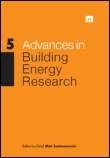
Advances in Building Energy Research
Scope & Guideline
Pioneering Sustainable Practices in the Construction Sector
Introduction
Aims and Scopes
- Energy Efficiency in Buildings:
The journal emphasizes research aimed at improving energy efficiency in various types of buildings, including residential, commercial, and public structures. This includes studies on HVAC systems, insulation materials, and energy-saving technologies. - Sustainable Building Practices:
A core aim of the journal is to promote sustainable building practices through the development and assessment of eco-friendly materials, renewable energy integration, and sustainable design strategies that minimize environmental impact. - Thermal Comfort and Indoor Air Quality:
Research focusing on thermal comfort and indoor air quality is a significant scope, exploring how building design and operation affect occupant comfort and health, which is crucial for enhancing the livability of indoor environments. - Innovative Building Technologies and Materials:
The journal seeks to highlight advancements in building technologies and materials, including smart building systems, energy-efficient construction techniques, and the use of innovative materials that contribute to sustainability and energy performance. - Modeling and Simulation Techniques:
A focus on computational modeling and simulation methods for predicting building performance is evident, with studies utilizing tools like CFD, BIM, and machine learning to optimize energy use and environmental conditions in buildings.
Trending and Emerging
- Integration of Smart Technologies:
There is a growing trend towards the integration of smart technologies in building management, including IoT and machine learning applications that optimize energy consumption and enhance operational efficiency. - Net-Zero Energy Buildings:
Research focusing on the design and implementation of net-zero and positive energy buildings is increasingly prominent, highlighting innovative solutions that balance energy consumption with renewable energy generation. - Life Cycle Assessment (LCA):
The application of life cycle assessment in evaluating building materials and energy systems is gaining attention, reflecting a broader understanding of the environmental impacts of building practices from construction to demolition. - Behavioral Energy Efficiency:
Emerging studies on occupant behavior and its impact on energy consumption are becoming more prevalent, recognizing the importance of human factors in achieving energy efficiency in buildings. - Sustainable Urban Development:
Research exploring sustainable urban development strategies, including energy performance in urban contexts and community-level interventions, is on the rise, indicating a shift towards holistic approaches in building energy research.
Declining or Waning
- Traditional Energy Sources:
Research related to traditional energy sources and their application in building design is becoming less prominent, as the focus shifts towards renewable energy solutions and sustainability. - Simple Energy Consumption Studies:
Studies that merely quantify energy consumption without integrating advanced technologies or sustainability assessments are seeing a decline, indicating a move towards more complex analyses that consider broader environmental impacts. - General Building Materials Review:
There seems to be a reduction in generalized reviews of building materials, as the journal increasingly favors research that assesses innovative or eco-friendly materials with a clear focus on energy performance and sustainability. - Thermal Performance of Conventional Systems:
Research focusing on the thermal performance of conventional heating and cooling systems is waning as new technologies and methodologies gain more attention, such as passive and hybrid systems that optimize energy use. - Basic Indoor Environmental Quality Assessments:
Basic assessments of indoor environmental quality without detailed analyses or innovative approaches are becoming less frequent, as the journal emphasizes more comprehensive studies that integrate occupant comfort with energy efficiency.
Similar Journals
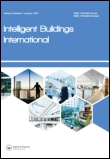
Intelligent Buildings International
Elevating Standards in Civil Engineering and ArchitectureIntelligent Buildings International, published by Taylor & Francis Ltd, is a premier journal dedicated to advancing knowledge in the interdisciplinary domains of building construction, civil engineering, computer science applications, and planning. Since its inception in 2009, this journal has become a vital resource for researchers, professionals, and students, offering a platform for high-quality scholarly articles that explore innovative strategies and technologies in intelligent building design and efficiencies. With its significant impact factor reflected in its Q2 and Q3 quartile rankings across various related fields, and strong Scopus rankings placing it among the top journals in Geography, Building, and Civil Engineering, Intelligent Buildings International stands out for its commitment to fostering research that enhances the sustainability and functionality of contemporary architectural practices. Readers can access a wealth of articles that illuminate the complexities of smart building technologies and their implications for future construction practices, making it an essential addition to any academic library.

Journal of Green Building
Transforming Spaces with Cutting-Edge Green Building InsightsJournal of Green Building, with its ISSNs 1552-6100 and 1943-4618, is a premier academic journal published by COLLEGE PUBLISHING in the United States. This journal, established in 2006 and continuing through 2024, serves as a vital platform for the dissemination of research on sustainable architecture, building technologies, and environmental design. With its current impact factor signifying a robust academic contribution, it is categorized in Q2 in Architecture and Q3 across several other disciplines, including Building and Construction, Environmental Engineering, and Public Health. The journal’s Scopus rankings demonstrate its strong positioning in the engineering and environmental science communities, making it an essential resource for researchers and professionals aiming to advance knowledge in green building practices. While it is not an Open Access journal, the rich content is pivotal for those involved in the critical intersection of sustainability and construction science. Whether you are a seasoned professional or a dedicated student, the Journal of Green Building offers invaluable insights that drive future innovations in eco-friendly building environments.
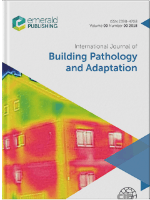
International Journal of Building Pathology and Adaptation
Elevating the standards of building pathology and adaptation.International Journal of Building Pathology and Adaptation is a premier publication dedicated to advancing knowledge in the field of building pathology and adaptation. Established by the esteemed Emerald Group Publishing Ltd, this journal serves as a vital platform for researchers and practitioners focusing on the assessment, preservation, and innovative adaptation of built environments. With an impressive Q2 ranking in both Building and Construction and Civil and Structural Engineering, and a Scopus ranking of #62 out of 223 in the relevant engineering disciplines, the journal showcases high-quality research with significant practical implications. Although currently not featuring an open-access model, its access options cater to a wide audience aiming to explore cutting-edge studies from 2017 to 2024. The journal's commitment to bridging the gap between academic inquiry and real-world application makes it an essential resource for anyone dedicated to advancing the resilience and sustainability of the built environment.
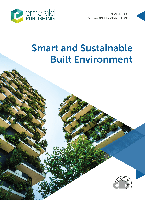
Smart and Sustainable Built Environment
Exploring the intersection of sustainability and architecture.Smart and Sustainable Built Environment, published by Emerald Group Publishing Ltd, is a prestigious journal dedicated to advancing the knowledge and practice of sustainable development within the landscape of modern architecture, building, and civil engineering. With an impact factor that reflects its strong influence and standing—illustrated by its consistent categorization in the Q1 tier across several relevant fields including Architecture, Building and Construction, and Urban Studies—this journal has become an essential resource for researchers, practitioners, and policymakers alike. Operating in the vibrant academic backdrop of the United Kingdom, it aims to publish cutting-edge research that addresses critical issues at the intersection of sustainability and built environments. The journal is also indexed in Scopus with impressive rankings, ensuring visibility and credibility. The scope of the journal encompasses a broad array of topics, encouraging contributions that discuss innovative practices, policies, and technologies to foster smart and sustainable development. With its dedication to publishing high-quality research from 2012 to 2024, Smart and Sustainable Built Environment is at the forefront of fostering dialogue and collaboration in the pursuit of sustainable solutions for our built environment.

International Journal of Ventilation
Transforming Knowledge into Sustainable PracticesThe International Journal of Ventilation, published by Taylor & Francis Ltd, serves as a critical platform for the dissemination of innovative research in the fields of building and construction, civil and structural engineering, control and systems engineering, and electrical and electronic engineering. With an ISSN of 1473-3315 and an e-ISSN of 2044-4044, this esteemed journal has maintained a significant presence since its inception in 2005 and continues to provide valuable insights for academics and professionals alike until 2024. Recognized in the 2023 rankings, it holds a Q2 designation in Building and Construction and Q3 status in several other engineering categories, reflecting its solid standing in the academic community. Despite its non-open access format, the journal remains a vital resource, focusing on advanced ventilation solutions that shape sustainable practices in building design and engineering systems. By publishing high-quality peer-reviewed articles, the International Journal of Ventilation plays a pivotal role in advancing knowledge, fostering collaboration, and inspiring future research within its dynamic fields of study.
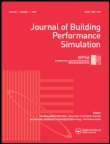
Journal of Building Performance Simulation
Exploring the Future of Architecture and Construction TechnologiesJournal of Building Performance Simulation, published by Taylor & Francis Ltd, is a premier academic journal dedicated to advancing the fields of architecture, building and construction, and computational modeling. With an ISSN of 1940-1493 and an E-ISSN of 1940-1507, this journal is recognized for its high-quality, peer-reviewed research, reflected in its impressive Q1 ranking in both Architecture and Building and Construction categories for 2023. Spread over a notable converged publishing timeline from 2008 to 2024, it aims to address contemporary issues in building performance and simulation methodologies, serving both practitioners and academics alike. Positioned within the 92nd percentile in Engineering - Architecture, the journal is a vital resource for professionals focused on innovative design and simulation technologies that enhance building efficiency and sustainability. Despite its robust reputation, the journal currently does not offer open-access options, which underscores its commitment to maintaining academic rigor. Engage with cutting-edge research that drives the future of building performance through this influential journal.
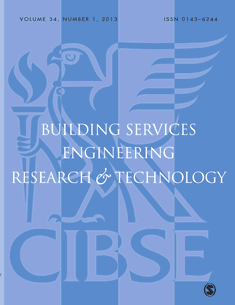
Building Services Engineering Research & Technology
Innovating the Future of Building Services ResearchBuilding Services Engineering Research & Technology is a leading journal published by SAGE Publications Ltd, dedicated to advancing the field of building services engineering. With an ISSN of 0143-6244 and an E-ISSN of 1477-0849, the journal has established itself as a vital resource since its inception in 1980, operating as an essential platform for disseminating high-quality research and technological innovations up to 2024. The journal is well-respected within the academic community, reflected in its Q2 category ranking in Building and Construction and a commendable 67th percentile rank among the 223 journals in its field, according to Scopus. Although it does not offer open access, it provides extensive insights and rigorous studies that are invaluable for researchers, practitioners, and students alike. As a central hub for the exploration of cutting-edge methods and principles in building services, the journal aims to foster a better understanding of sustainable and innovative practices within the industry.

Buildings
Innovating Sustainable Solutions for Modern InfrastructureBuildings is a premier peer-reviewed journal published by MDPI, focusing on the multidisciplinary aspects of architectural and civil engineering. Established in 2011, this Open Access journal has quickly gained recognition in the academic community and is currently classified in the Q1 category for Architecture and Q2 for Building and Construction, as well as Civil and Structural Engineering, reflecting its significant impact within these fields. With Scopus rankings placing it in the top tier of architecture and construction disciplines, Buildings provides a platform for innovative research and practical applications that push the boundaries of knowledge in building design, sustainability, and infrastructure development. The journal, based in Switzerland and intended for an international audience, welcomes various types of content including research articles, reviews, and case studies, ensuring a comprehensive resource for researchers, professionals, and students alike.

Building Simulation
Unlocking the Potential of Sustainable ArchitectureBuilding Simulation is a leading academic journal published by TSINGHUA UNIVERSITY PRESS, focusing on the critical intersection of building and construction and energy efficiency. With its ISSN 1996-3599 and E-ISSN 1996-8744, this journal stands out in the Q1 category for both Building and Construction and Energy (miscellaneous), as recognized in the latest 2023 category quartiles. It has established itself as an influential platform for disseminating innovative research and developments in building performance simulation and energy use optimization, boasting impressive Scopus rankings at Rank #15/223 in Engineering (Building and Construction) and Rank #15/78 in Energy (miscellaneous), placing it in the upper percentiles of its field. Since its inception in 2008, the journal has fostered a rich dialogue among practitioners, researchers, and students, empowering them to advance sustainable building practices and contribute to global energy conservation efforts. Building Simulation is an open-access journal, making its valuable content accessible to a worldwide audience, further enhancing its role as a vital resource in the quest for innovative building solutions.

Gradevinar
Fostering Collaboration in the World of Civil EngineeringGradevinar, published by the Croatian Society of Civil Engineers-HSGI, is a leading Open Access journal in the field of Civil and Structural Engineering, with a significant history that dates back to its inception in 1980. This journal, with the ISSN 0350-2465 and E-ISSN 1333-9095, has established itself as a vital platform for disseminating innovative research and practical developments in civil engineering, particularly since it became Open Access in 2000, facilitating unrestricted access to its wealth of knowledge. As of 2023, Gradevinar is ranked in the third quartile (Q3) of Scopus’s Civil and Structural Engineering category, demonstrating its growing influence and relevance in the academic community, with a current ranking of #255 out of 379 journals in the field. Researchers, professionals, and students benefit from this journal's commitment to high-quality content that reflects the latest advancements and best practices in civil engineering, contributing to both technical proficiency and sustainable development in infrastructure projects across Croatia and beyond.